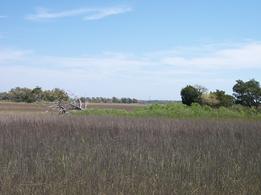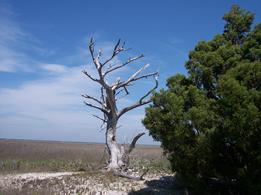Low tide 8:03AM. Predicted winds SW 15-20 knots; 20 knots later.
I arrive at the Romain Retreat landing at 10AM, and the breeze is solid already. A commercial fisherman is steaming in through Anderson Creek, and I recognize the homemade roof as a crabber I have seen the past two years in McClellanville. He turns north and heads up the ICW. I am off about 10:20AM, and the tide has been coming in for a couple of hours. My plan is to reach out in the southwest breeze against the tide until I reach the waters of Bulls Bay near the entrance to Bull Creek. Heading upwind, I will beat up Bull Creek until taking a waterway to port into the entrance to Back Creek. I will continue upwind, taking the fork toward Bull Island until finally reaching a hammock located next to a sharp curve in the creek. A landing and full exploration of this hammock is also on the agenda.
On the sail out I pass a johnboat with a couple and young child in the sheltered waters. We are planing steadily, and as the waters and wind open up past the Shark Hole, we fly by two boats fishing near the mouth of Anderson Creek. A chop creates some bounces, but progress is rapid. After a couple of minutes, one of the fishermen heads out behind on a course for the Northeast Point, while our course takes us further to the south close to the large shoal to starboard.
On arrival at the place where the waters from the bay funnel into Bull Creek to the south, the opposed southwest wind and incoming tide throw up steep and bunched together seas, making my beat to windward all the more challenging. The wind is blowing strong, and at times we are overpowered. I am banging Kingfisher through these conditions and getting very wet despite raingear jacket and pants. We stay closer to the Bull Island shore, hoping to stay out of the worst of the waves, but in taking long tacks and being pushed by the incoming tide I find we are out in the waves again. A pod of dolphins appears in a usual place from past sightings. Continuing the struggle to get to windward a larger pod appears straight ahead on our course. In the opening to Summerhouse Creek ahead, Island Cat appears at the dock. For the best course we stay to the starboard side of the marsh island positioned in the middle of Bull Creek, and find some smoother water near this isle of grass. The maximum incoming flow is giving quite a push, and progress is good as we take the southern fork of Bull Creek. When this creek turns back to the west, the entrance to Back Creek continues our course to the south and upwind.
Back Creek is a narrower waterway, and tacks are required more frequently. I imagined earlier that at some point we would be reaching off, but the way continues to be to windward. Earlier I pulled the plug in Bull Creek to get some of the water out of my cockpit. The windward heading is not allowing the drain to remove water, and with the waves encountered earlier I find we have at least two inches of water sloshing around in the cockpit. The creek slowly narrows as we continue beating, and each tack becomes shorter and soon followed by another. The wind continues strong as we close on the hammocks ahead in the marsh, noted on an earlier chart as the “Pine Islands”. The sail to windward is much longer than I recall from my only visit here perhaps three years ago. A small leg of the creek to the southeast bends right next to the hammock. I tack before the bank, and make a short return to attempt to drain some water on a reach, but without much success. I return toward the hammock, round up and drop sail, and drift in to the hammock. The wind pushes us back further than the spot I picked to land, and now I am almost on a bank populated by pluff mud and oysters. Pulling out the paddle I manage to battle the wind and get back to a better landing spot. Stepping out on the bank I find pluff mud plastered onto my sandals.
After securing Kingfisher and grabbing lunch and camera, I step up on the hammock and proceed on a walk around the isle. Shell midden is scattered throughout all sections of this hammock. Unlike Jeremy Island, potshards are not abundant. Past relic hunting via digging in the midden is evident .
I step up on the hammock and proceed on a walk around the isle. Shell midden is scattered throughout all sections of this hammock. Unlike Jeremy Island, potshards are not abundant. Past relic hunting via digging in the midden is evident .  This hammock is similar to others in the refuge in that it has a large stand of red cedars, along with some palmettos and live oaks. Well-beaten wildlife trails circle and crisscross through this isle, and these paths reach off to some of the other nearby hammocks.
This hammock is similar to others in the refuge in that it has a large stand of red cedars, along with some palmettos and live oaks. Well-beaten wildlife trails circle and crisscross through this isle, and these paths reach off to some of the other nearby hammocks.  My walk meanders around, using the wildlife paths and walking around the edge. I come upon an open area with a nice group of prickly pear brightly colored with splashes of yellow, green, and red. Nearby on perhaps the high spot of the hammock is a decent sized live oak tree, and a ring of palmettos creates a space of some distinction.
My walk meanders around, using the wildlife paths and walking around the edge. I come upon an open area with a nice group of prickly pear brightly colored with splashes of yellow, green, and red. Nearby on perhaps the high spot of the hammock is a decent sized live oak tree, and a ring of palmettos creates a space of some distinction.
I finally make it around to the northern point, with a view out to several of the other hammocks. A large dead cedar marks this point that is also paved with solid shell midden, including extensive clam shells. Live cedars back up the wizened and dead sentinel. From here I return to my landing spot, and sit down to eat lunch. The breeze is still strong. I rig up carefully, and disembark from this isle, taking care to get the pluff mud off my sandals as I sail off, now downwind and retracing my earlier course. We pick up speed quickly and are up a plane. The progress is much quicker than the earlier windward sail, with no tacks or jibes required. Before I leave Back Creek, I can see Island Cat’s roof above the marsh grass ahead, taking the second group of the day over to the island. Another sighting is worth all the effort required by today’s sail – a small loggerhead taking a breath just a few yards to port. It could easily have been missed with the concentration on sailing necessitated by the intensity of the wind. My course returning to home will be the ferry route, so in fact I will continue in the waterway to the north. But in the spur of the moment I steer instead to the east to reach over to Summerhouse Creek and the dock.
Live cedars back up the wizened and dead sentinel. From here I return to my landing spot, and sit down to eat lunch. The breeze is still strong. I rig up carefully, and disembark from this isle, taking care to get the pluff mud off my sandals as I sail off, now downwind and retracing my earlier course. We pick up speed quickly and are up a plane. The progress is much quicker than the earlier windward sail, with no tacks or jibes required. Before I leave Back Creek, I can see Island Cat’s roof above the marsh grass ahead, taking the second group of the day over to the island. Another sighting is worth all the effort required by today’s sail – a small loggerhead taking a breath just a few yards to port. It could easily have been missed with the concentration on sailing necessitated by the intensity of the wind. My course returning to home will be the ferry route, so in fact I will continue in the waterway to the north. But in the spur of the moment I steer instead to the east to reach over to Summerhouse Creek and the dock.
The reach east in Bull Creek is very fast, and soon around the point of marsh I head up into Summerhouse Creek for the sail to windward. Island Cat is gathering passengers for the ride back to the mainland. As I sail by the dock, the captain Michael Burpee walks out on the dock to say hello. He comments on the abundance of horsepower for my sail. I make my turn, and jump back on a plane to come out of Summerhouse Creek, and then come up closer to the wind for this section of Bull Creek. After a while I see the ferry leaving the dock and coming in my wake. Reaching the fork we head north, jumping back onto a full plane. After negotiating the bends in the creek, we finally bear off into the straight section adjoining Sewee Bay, running swiftly through this narrow waterway. We make it through without a jibe, and pass an outboard moving in the opposite direction. The roof of Island Cat appears at times over the marsh, but our pace keeps us easily ahead sailing back across to the ICW. The last section requires us to sail closehauled again, and my left wrist is getting tired from this long sail on the port tack. Making the ICW, I take the time to reach back and forth across the waterway between the mainland and into the beginning of the ferry passage, jumping across the waves generated in this waterway. We soon bear off for the run north to the Romain Retreat landing. This distance is soon covered, and after rounding up and dropping sail, I steer Kingfisher downwind with the push of wind and tide into the landing.